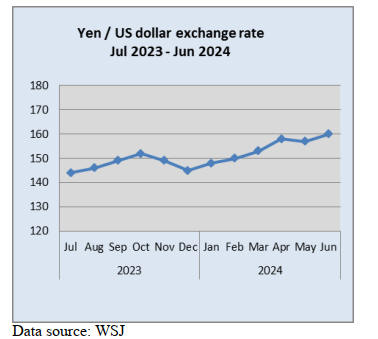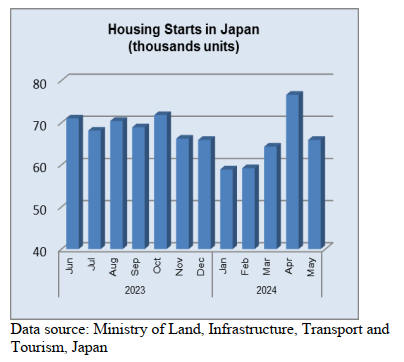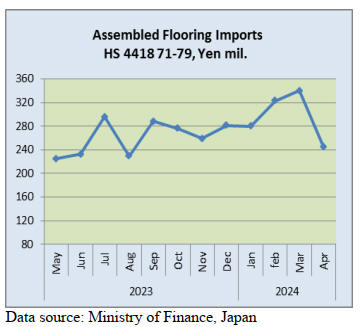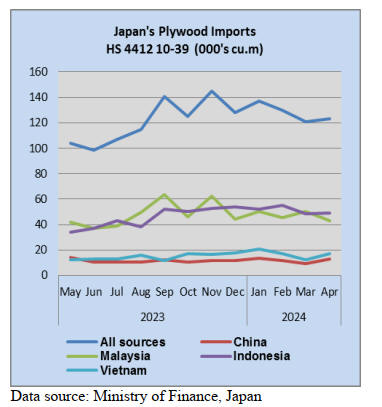Japan
Wood Products Prices
Dollar Exchange Rates of 25th
Jun
2024
Japan Yen 160.71
Reports From Japan
No clear signs of economic recovery challenges
Bank of Japan
Japan’s economy has yet to show clear signs of recovery
making decisions on the timing of its next interest rate rise
difficult. GDP shrank at an annualised pace of 1.8% in the
first three months of this year compared with the 2%
decline reported in preliminary data. The data showed both
consumers and companies cutting back on spending and
unsold supplies building up.
Cash handouts for low-income households
The Japanese Prime Minister has announced the
government will compile fresh inflation relief steps in the
autumn, providing cash handouts to low-income
households struggling with the cost-of-living. The aid will
come on top of government subsidies that will be retained
to lower household utility bills. Rising prices continue to
weigh heavily on consumers.
See:
https://english.kyodonews.net/news/2024/06/13090c42094a-
update3-japan-pm-says-new-inflation-relief-steps-to-be-drawn-
up-around-
fall.html?phrase=foreign%20labor&words=#google_vignette
However, there is some positive news. Retail trade in
Japan expanded year on year by 3% in May according to
data from the Ministry of Economy, Trade and Industry.
Month-on-month, the figure grew by 1.7%. This was
above analysts' expectations. Commercial sales jumped
5.6% year-over-year while increasing 2% on a monthly
basis.
The seasonally adjusted value of sales in the wholesale
industry surged 6.7% compared to May 2023. The figure
expanded by 2.3% compared to the previous month.
Private consumption in Japan accounted for 54% of
nominal GDP in March 2024 and the slump in
consumption contributed to the economic contraction in
Q1 2024. Private consumption fell by almost 1% in the
first quarter 2024 with the Japanese economy contracting
by 0.5% quarter-on-quarter.
Capital investment falls
The Cabinet Office has reported core machinery orders
fell in April for the first time in three months casting some
doubt about the strength of capital spending which is key
to a durable economic recovery. Despite the fall the
Cabinet Office left its assessment of machinery orders as
“showing signs of picking up’, unchanged from a month
earlier.
Core orders fell 2.9% month-on-month in April, the first
drop in three months. Machinery orders are highly volatile
data series regarded as an indicator of capital spending in
the coming six to nine months.
Japanese firms have plans to boost output but are now
cautious due to uncertainty over the economic outlook.
The weakening of the yen has not helped domestic capital
investment.
See: https://www.esri.cao.go.jp/en/stat/juchu/2024/2403juchu-
e.html
Companies say prolonged yen weakness will undermine profitability
In May 2024 Japan’s exports grew at the fastest rate since
2022 driven by the steady fall in the value of the yen
against major currencies, a positive development for the
manufacturing sector.Exports increased 13.5% year on
year in May, the sixth monthly advance according to
Ministry of Finance data. Japan’s exports to the United
States jumped 24%, while those to China increased 18%
but shipments to the European Union fell by 10%.
There are reports of growing concern among importers
about a cycle of cost-push inflation. More than 60% of
Japanese firms surveyed and reported by Teikoku
Databank said prolonged yen weakness will undermine
profitability.
See:
https://www.japantimes.co.jp/business/2024/06/19/economy/japa
n-
exports/?utm_source=pianodnu&utm_medium=email&utm_cam
paign=72&tpcc=dnu&pnespid=o.ymki1n_lvy87jttac0rkgd50azox
x6naovdlej6kuvl3mwqteenbh01pthkvw0yavjuq
Earnings from tourism second only to auto exports
Spending by foreign visitors in Japan has quintupled over
the past decade to become Japan's second-largest export
category after automobiles but higher than electronic
components, including semiconductors and steel exports,
underscoring a shift from goods to services.
Government data shows quarterly spending by visitors
grew over 60% in the five years through the first quarter of
March 2024 while annual exports of autos and steel each
rose around 45% between 2019 and 2023 and electronic
components climbed less than 40% in that period.
See: https://asia.nikkei.com/Economy/Tourism-surges-to-Japan-
s-No.-2-export-behind-
cars?utm_campaign=GL_JP_update&utm_medium=email&utm_
source=NA_newsletter&utm_content=article_link

Expectations of another currency market
intervention
Recent currency interventions by Japanese authorities
have had little effect on strengthening the yen exchange
rate and towards the end of June the yen fell to historic
lows against the US dollar, Swiss franc, British Pound and
more.
The Japanese government and the BoJ spent 9.7 trillion
yen (US$61.4 billion) intervening in the currency market
in April and May but the yen continues to depreciate and
was at 160 to the US dollar at the end of June. Comments
after the Bank of Japan's (BoJ) mid-month policy fueled
selling pressure on the yen.
One issue is the interest rate gap with the US where
interest rates are now around 5%. The US Federal Reserve
is also not expected to start cutting interest rates until at
least the fall.
Japan has a new foreign exchange ‘diplomat’ to take
control as the yen plumbed a 38-year low against the US
dollar heightening expectations of another currency
market intervention to support up the battered yen. Atsushi
Mimura, a financial regulation veteran, replaces Masato
Kanda who launched the biggest yen-buying intervention
on record this year.
In related news, the US Treasury Department added Japan
to its "monitoring list” for foreign-exchange practices but
stopped short of labeling Japan or any other trade partner
as a currency manipulator.
A statement from the US Treasury Department said
"Treasury’s expectation is that in large, freely traded
exchange markets, intervention should be reserved only
for very exceptional circumstances with appropriate prior
consultations” adding "Japan is transparent with respect to
foreign exchange operations.”
See:
https://www.japantimes.co.jp/business/2024/06/21/markets/us-
currency-
watchlist/?utm_source=pianodnu&utm_medium=email&utm_ca
mpaign=72&tpcc=dnu&pnespid=87.iijrhua2f.k2x9bbzrftktqmdo
scokrb4e0ljrxavo_rjoyu59q7u9uns17dtevtuba

Derelict houses fueling a cycle of weak prices in some
urban areas
Abandoned and derelict homes in Japan are pulling down
the value of surrounding properties with losses forecast at
as much as US$24.7 billion in the five years through to
2023 according to estimates by the Japan Akiya
Consortium. This huge sum highlights the scale of a
problem that is fueling a cycle of weak prices in some
urban areas.
The forecast was compiled by the Japan Akiya
Consortium, which brings together 14 companies and a
research institution to tackle the problem of abandoned
homes. The figures were based on 2023 government
statistics and research by the Center for Real Estate
Innovation at the University of Tokyo.
The researchers note that “while the Ministry of Land,
Infrastructure, Transport and Tourism said that residential
land prices rose for three consecutive years until 2024,
abandoned houses may have suppressed the rate of that
increase”.
See: https://asia.nikkei.com/Business/Markets/Property/Japan-s-
abandoned-houses-wipe-25bn-off-nearby-property-value

Import update
Assembled wooden flooring imports
The value of imports of assembled wooden flooring
(HS441871-79) in April 2024 was up 22% from the same
month in 2023 which is significant given the pace at which
the yen exchange rate has fallen over the past 12 months.
Compared to the value of March 2024 imports, there was a
28% decline in April.
In April the main category of assembled flooring imports
was HS441875, accounting for almost 75% of the total
value of assembled flooring imports of which shippers in
China accounted for 40%. Japan is a major market for
flooring from China but flooring manufacturers are facing
challenges in other international markets (see also page
17) The second largest category in terms of value was
HS441879 followed by HS 441874. The main shippers of
assembled flooring in April were China, Vietnam,
Malaysia and Indonesia.

Plywood Imports

Year on year in April 2024 there was a 17% rise in the
volume of plywood imports into Japan and at 123,514
cu.m the volume of April imports was little changed from
that in March (121,000 cu.m).
Of the various categories of plywood imported, 84% was
HS441231 in April with HS441233 and HS441234
accounting for the balance. The four main shippers of
plywood to Japan, Indonesia, Malaysia, Vietnam and
China consistently account for over 90% of plywood
imports.
The Japan Lumber Report says that in April 2.4mm 3ft x
6ft plywood from SE Asia was wholesaling/delivered at
around US$950 per cu.m while 3.7mm plywood was
around US$880. The price for 5.2mm panels was around
US$850 per cu.m.

Trade news from the Japan Lumber Reports (JLR)
The Japan Lumber Reports (JLR), a subscription trade
journal published every two weeks in English, is
generously allowing the ITTO Tropical Timber Market
Report to reproduce news on the Japanese market
precisely as it appears in the JLR. For the JLR report
please see: https://jfpj.jp/japan_lumber_reports/
100 % falcata FSC plywood
PT. Semeru Makmur Kayunusa in Indonesia got a
certification of FSC’s (Forest Stewardship Council) FM
(Forest Management) on its own 3,005 hectares of
plantation. The company is now able to supply FSC
plywood made of all falcata layers. Monthly production of
FSC falcata plywood will be 10,000 cbms.
The company has already got the certification of FSC’s
COC (Chain of Custody) at its plywood plant in April,
2024. Sojitz Building Materials Corporation in Tokyo,
Japan, which is a sole agent of PT. Semeru Makmur
Kayunusa, also has the FSC’s COC certification so the
companies are ready to supply the FSC products.
Semeru Makmur Kayunusa is a pioneer of supplying
falcata plywood at the Japanese market and the company
established a plant in 2013. Moreover, the company
established its second plant in 2016. The company started
producing plywood made of MLH and falcata in February,
2023.
Normal plywood and structural plywood of Semeru
Makmur Kayunusa are certificated as JAS (Japanese
Agricultural Standards). Monthly plywood production is
6,500 cbms. There are about 1,200 employees at the
company.
Total plywood supply to Japan in 2023 is about 63,000
cbms. Now, the company produces 1,200 – 1,500 cbms of
normal plywood, 1,500 cbms of base plates for floors and
1,000 – 1,500 cbms of structural plywood in a month. The
company also produces 5,000 – 6,000 cbms of other kind
of plywood. The company aims to produce 68,000 cbms of
plywood in this year.
The company applied the FSC certifications due to the
growing need for FSC certifications in the world. The
company applied by “Community - Forestry”, which is a
group of local farmers plant trees by themselves. Sojitz
Building Materials plans to import more plywood made of
plantation timber and certified forest products than last
year.
Long softwood plywood for structures
Jutec Corporation in Tokyo Prefecture started selling its
original brand called “Ju-Jitsu eco” and “PEFC long
softwood structural plywood” in June, 2024. The company
has been expanding selling certificated products such as
laminated large boards with the PEFC certification since
this spring.
According to the company, it is the first company to sell
long softwood plywood with the PEFC certification in this
industry. The company will consign its products for sale to
Seihoku Corporation in Tokyo Prefecture, Ishinomaki
Plywood Manufacturing Co., Ltd. in Miyagi Prefecture
and Nisshin Group in Shimane Prefecture to produce long
softwood plywood for Jutec and will sell the long
softwood plywood in Japan expect Hokkaido Prefecture.
The size of long softwood plywood is 9 mm thickness, 3 x
8, 3 x 9, and 3 x 10. In Tohoku area, the long softwood
plywood is made of all Douglas fir layers or Douglas fir
layers on front and back and domestic red pine layers is
inside of the long softwood plywood.
In central Japan, domestic larch layers or Douglas fir
layers are used on front and back. Cedar layers are used in
the middle of the long softwood plywood. In western
Japan, Douglas fir layers are used on front and back and
cedar layers are used in the middle of the long softwood
plywood.
Domestic larch, red pine and cedar are certificated as the
SGEC (S) but the company will supply 100 % PEFC
certificated plywood. The company has also normal
plywood with the FSC certification and has domestic
softwood plywood with the FSC certification. The long
softwood plywood with the PEFC certification is delivered
to major DIY stores.
South Sea Logs and Lumber
The inventories of lumber for decks and laminated large
boards have been declining and consumers started to
purchase lumber. Demand for trucks has been increasing.
Hardwood trees in the temperate zone are highly priced
and inquires for furniture and interior materials used at
luxury apartments are firm. However, domestic hardwood
timber or domestic hardwood sheets are used for general
public.
It is difficult to forecast that demand would recover or not.
Since the yen had been nearly 160 yen against the dollar
and it is hard to lower the selling price in Japan. There is
no shortage of South Sea logs because a certain volume of
South Sea logs have arrived to Japan in March 2024.
Daiken shows carbon stocks on catalogue
Daiken Corporation in Osaka Prefecture shows carbon
stocks on its several products, such as floors and interior
doors, on its catalogue and website. The reason is to
realize the carbon-neutral. 14 popular products, which are
used at houses and public buildings, show the carbon
stocks. The company has showed about 739,000 tons of
carbon stocks of insulation boards and MDF before. The
company expands to show products’ carbon stocks.
The products, which show the carbon stocks this time, are
called “Communication Tough Ⅱ DW” and show about
12 kg of CO2, per square meter.
There are a lot of inquiries for the products because
consumers are able to place a special order for the
products. Other products, such as single doors, show about
39 kg of CO2. It would be about 2,372 kg of CO2 if
Daiken’s products were used for a house.
|